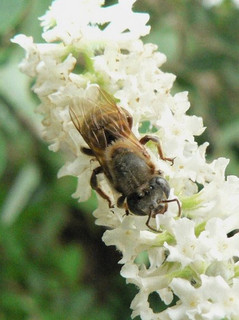
The Sacred Mayan Bee:
Melipona beecheii
The purpose of this site is to organize data
on a very interesting species of stingless bee, Melipona beecheii,
and put it in a database of collections of other species profiles.
We hope that this resource is an approachable guide to the many
facets of Melipona beecheii as well as a referenece to further
understanding of this bee's place in the biological timeline.
Melipona beecheii is an interesting character in the Apidae family
for quite a few reasons. Maybe the most striking is its role in
ancient Maya culture. The collection of honey from this particular
species was spiritual and ritualistic, as these bees were seen as a
lineage of the gods. It has also been shown that the Melipona
beecheii honey has anti-microbial properties, and was used as
medicine by the Maya (Rosales 2013). 
Of course,
the region that M.beecheii inhabits overlaps with that of the Maya,
as the bee is known to reside in a range from Mexico to Costa Rica
(EOL 2013). Melipona beecheii shares many characteristics with other
honey bees such as two pairs of wings, hair covering the body, and
two large compound eyes (Snodgrass 1957). One major feature that
distinguishes Melipona from other honeybees is the lack of a
functional sting (EOL 2013). Melipona also has common characters
with other insects such as its exoskeleton and internal muscles, six
jointed legs as well as a larval, pupal and adult stage (Snodgrass
1957).
Common to all bees, M. beecheii uses the nectar and pollen from
flowers for energy and protein (Schaafsma, 2006). In return for the
flowers resources the bee contributes greatly to its pollination
(Ramalho, 2004). Not all the bees relationships are to its benefit,
however, as seen with the parasitic phorid fly and its competition
between the European and Africanized honeybees to survive (Bellows,
2012). How could I forget the more-than-just-tasty relationship we
maintain with M. beecheii? This relationship dates back all the way
to the Mayans who worshiped the bee (Villanueva-G et al. 2005) and
used its honey in many different ways (Bellows, 2012).
One aspect of M. beecheii perfected by the Mayans was their ability
to reproduce them. With the help of worker bees the queen can
reproduce many larva that will grow to help the hive. However, some
of those will eventually be killed by their own species (Jarau et
al., 2009)! To learn more about this magnificent species explore the
next pages. To discover more organisms follow
http://MultipleOrganisms.net.